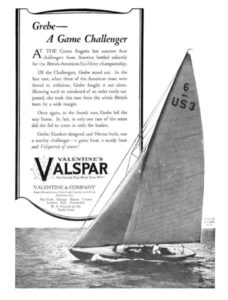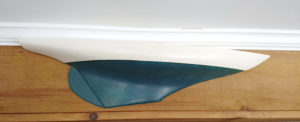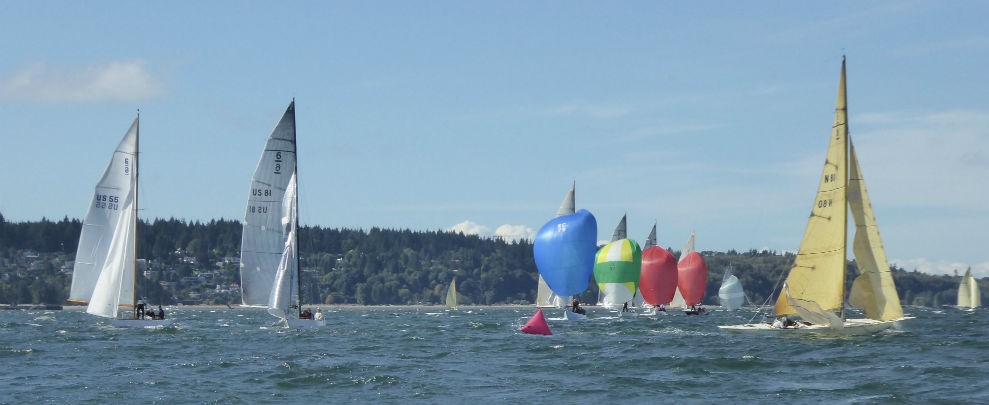The boats that sailed a century ago – part 5: Grebe
June 29th, 2021

100 years of racing
2021 is the centenary year of the British American Cup, the first major trophy for international team racing. The competition was hugely popular and was a further boost for the increasingly successful International Six Metre Class.
The eight entrants in 1921 – four each for Britain and America – were launched in the same year. This is part of a series of posts to mark the centenary of the launch of the eight pioneering international team racing boats.
The American team – Grebe

Photo of Grebe from The Washington Herald, September 1922.
Britain were the clear favourites to win the inaugural British American Cup; they were racing in their own waters which were unfamiliar to the Americans. Britain had also talked America into racing with International Rule boats, of which America had none. They would be starting from scratch and with somewhat unconventional boats among their number. The British, on the other hand, were able to select their four entrants during rigorous trials of up to fourteen Six Metres, whose designers included William Fife III, Alfred Mylne, Camper Nicholson and Frank Morgan Giles. It was no surprise that Britain won convincingly.
The American Montauk, Jeanie and Sheila showed some promise, but there was one American boat that gave the world a glimpse of their future dominance in the competition; a boat who did not look out of place alongside the British designs.
Her name was Grebe (not to be confused with the 1909 French Six of the same name). She was built by Henry Nevins boatyard and designed by William Gardner, who received his education in Britain and would have observed yachts of the International Rule.
Grebe was built for J L Saltonstall, E Townsend Irvin and Richard “Dick” De Blois Boardman.
How paths cross
An examination of the history of the crew of the American team shows how their lives had intertwined.
Saltonstall had enrolled his own motor boat into the Naval Coast Defence Reserve in 1917 and it was formerly taken over by the US and named USS Scoter. Scoter was built by George Lawley & Son, whose president was Frank Paine. Paine co-designed Jeanie, which he sailed as a crew member at the 1921 British American Cup.
Saltonstall was transferred to London US Naval Headquarters in 1918 and was assigned duty as US Navy liaison officer at the British Admiralty – just as Paul Hammond, owner of Sheila, had also been sent to Britain. Dick Boardman and E Townsend Irvin were also both lieutenants in the US Navy, having started in the Coast Defence Reserve.
And all were members in 1921 of the Seawanhaka Corinthian Yacht Club in New York.
The races
“Grebe proved to be the best boat on the American team, but that may have been partly because of Boardman’s great amount of experience in International racing on both Sonderboats and Seawanhaka Cup challengers and defenders.” L Francis Herreshoff, 1961.
Perhaps Boardman was more familiar with the short sharp waters of the Solent, but a greater factor in Grebe’s success was her design. With neither the short ends of Sheila, nor the long ends of the Fife Sixes, and the largest hull of the competitors, Grebe was well suited to the harsh water and big winds. It has already been mentioned in earlier posts that Grebe was the only American to finish the first race undamaged. In fact she won it coming ahead of the British Flya.
After the British American Cup
Grebe was a clear source of pride for America. She appeared in an advert for Valspar varnish, celebrity-like, in 1922 along with the following text:

Grebe featured in an advert for Valentine’s Valspar yacht varnish in 1922.
“Of the Challengers, Grebe stood out. In the first race when three of the American team were forced to withdraw, Grebe fought it out alone. Showing work to windward of an order rarely surpassed, she took this race from the whole British team by a wide margin. Once again, in the fourth race, Grebe led the way home. In fact, in only one race of the series did she fail to come in with the leaders.
Grebe, Gardner designed and Nevins built was a worthy challenger — a game boat, a sturdy boat and Valsparred of course!”
Grebe raced again in 1922, again with Dick Boardman and E Townsend Irvin. She placed third in the final four races and was the second highest scorer for the Americans behind Lea with Sherman Hoyt at the helm.
Memories of Grebe by Ron Ginger

Grebe on the hard in the late 1960’s.
“I first encountered Grebe about 1966 or ’67. It was purchased by Eger Palmer and brought to Keans Detroit Marina on the Detroit River. At that time it had an open cockpit and flush decks. Eger rebuilt all stainless steel parts to fully re-rig the mast. He then stripped the deck and laid a two layer plywood deck with a small self-draining cockpit and house with a sliding hatch. I have a small section of deck beam and carling I saved that showed the fine construction of the boat.
“I sailed with Eger many times over the next couple summers. Grebe was an amazing boat to sail, fast and very responsive. We did not race the boat as there was no suitable class in the area.

Eger Palmer added a cabin to Grebe in the late 1960’s.
“Eger told me he wanted to enter the single hand trans-Atlantic race. He planned to truck the boat to the east coast and sail across the Atlantic as his qualifying sail. I started to do more work on the boat to help him. I removed a bulging garboard plank and discovered the boat was fastened with brass screws and they were all in bad condition from loss of zinc. They simply crumbled when any force was applied to remove them. This stopped Eger’s thought of the race as there was not time to refasten the boat.
“I continued to sail with Eger for a year or two on the Detroit River (I owned a Folkboat at that time). About 1968 or ’69 Eger moved to central Michigan and as far as I know simply left the boat in a very low-end boatyard. I moved to Massachusetts in 1971, but visited Detroit about yearly. I looked in on the boatyard a few times in the next years and eventually Grebe was gone. I have no idea what happened.

Ron Ginger’s half model of Grebe.
“I measured Grebe and created a lines drawing and carved a half model to give to Eger. I know the model passed to his step-son on his death in the mid ’70s. I later made another half model (the opposite side) which is now on the wall above my desk. I was never quite sure I had the model right in the area where the stern breaks the water, there is a hard spot in my model that I am sure was not in the boat.”
Where is she now?
In the Classic Six Metre newsletter no. 5, Tim Street noted:
“USA 3 Grebe was, in 1996, going free to a good home. She was believed to be restorable and was lying in Detroit. Unfortunately she may have already been destroyed as I was told of a boat, lying in a car park in Detroit, by an English businessman, who saw it and wanted to buy it. When he went back to try and buy her he was told that she had been taken away and destroyed.”
However, Grebe was listed in 2007 and 2008 on the Classic Six Metre Newsletter database of classic sixes still in existence (Newsletter edition no. 12), registered in New York.
It has more recently been suggested that Grebe is lost, having disappeared into the woods of Minnesota.
We would be delighted to hear from readers with further knowledge of Grebe, or any of the 1921 British American Cup competitors. Please contact us here.
Posted in Anniversary by James Harris on June 29th, 2021. Tags: British American Cup, Grebe, Nevins, Sailing, Six Meter, Six Metre, William Fife, William Gardner
Subscribe to comments | Both comments and pings are currently closed.
We need your support
Support our project and submit your records or make a donation to the International Six Metre Archive.
